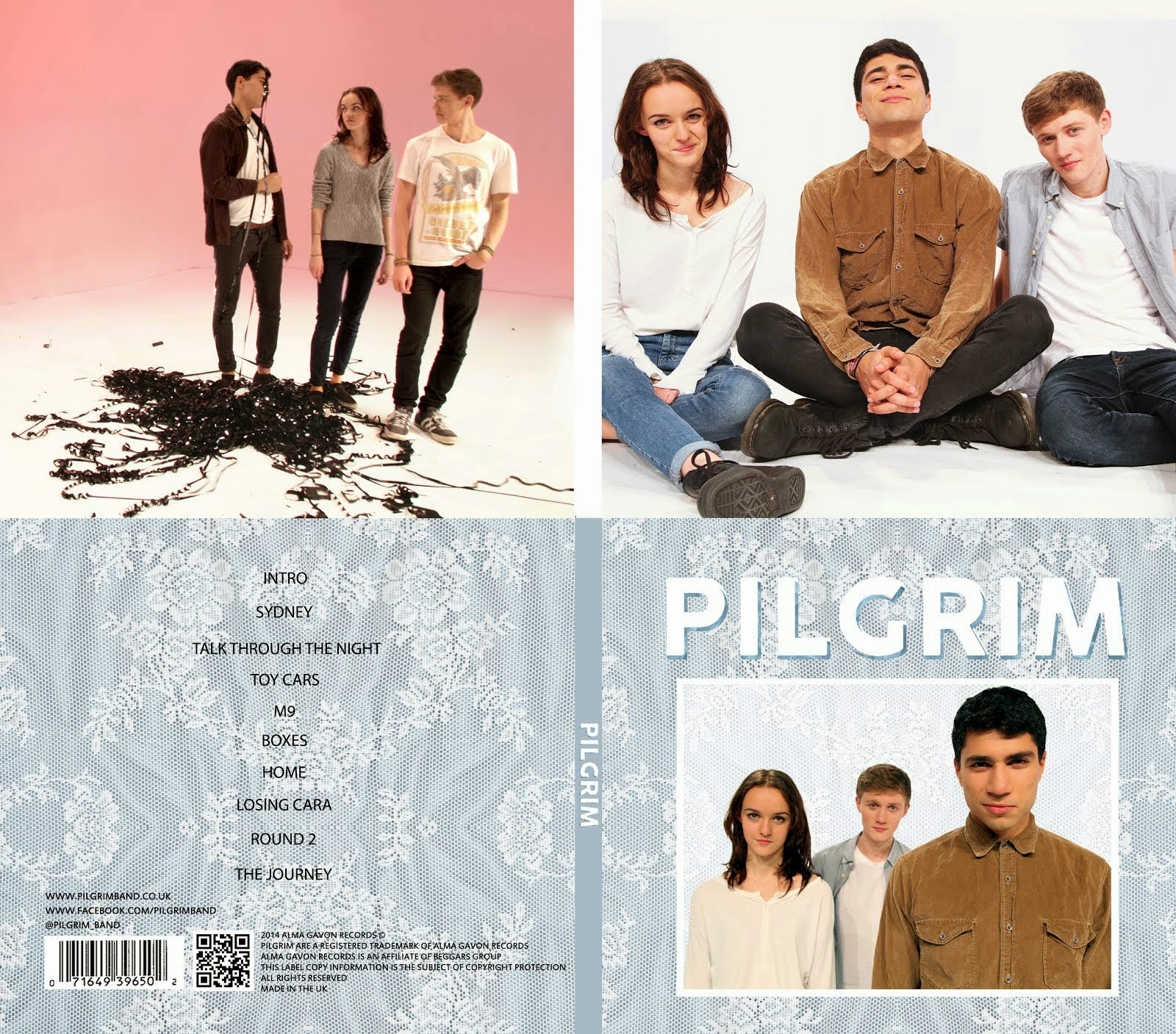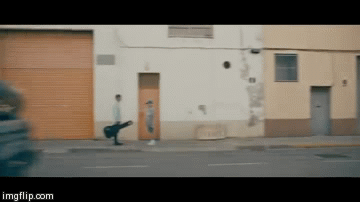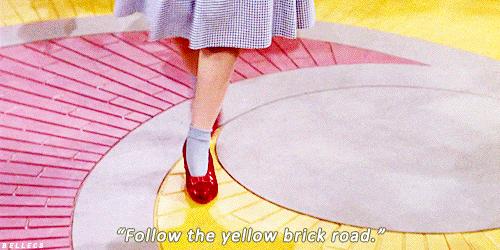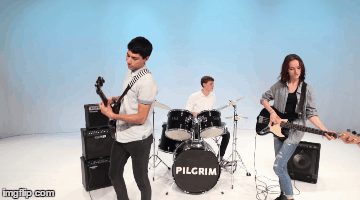This Blog Is Now Closed
Our Music Video
Our Music Video
Digipack

Our Digipack (Bottom Right, anti-clockwise: Front Cover, Back Cover, Left Inside Panel, Right Inside Panel)
I am part of Group 1 along with Alice Cahill (0130), Kayvon Nabijou (0610) and Gavin Fraser (0245).
You can navigate my blog using the right hand side column where you will find:
My A2 post labels including posts for the A2 Prelim, A2 research and planning and A2 Production
A live link to The Latymer School Music Video Blog
The blog archive of all my posts
Thank you for taking the time to look at my blog
Here is the live link to Group 1's Facebook Page
Monday, 26 January 2015
Monday, 29 December 2014
1. In What Ways Do Your Media Products Use, Develop Or Challenge Forms And Conventions Of Real Media Products?
When creating our three artefacts we looked at real media texts and took influence from them in order to conform to the forms and conventions of our artefacts. We used, developed and broke conventions across our music video, website and album cover.
In our video we referenced childhood by having Pilgrim mess about with popular toys from 1990-2000s. Below is a video I made of the intertextual and post-modern references in our music video:
Often in indie music videos, post-modern references are included in order to add humour. We decided to parody the Rap genre, namely Fat Joe's video for 'Make It Rain' featuring Lil Wayne. We thought that this would be a good way to reflect the band's fun and playful side.
Camerawork + Framing
One of Carol Vernallis' key concepts, to do with the construction of music videos, is camera movement and framing. She states that extreme shot types are very common, the style of camerawork is distinctive to that video and establishing & close up shots are used frequently. Goodwin also states this, saying that record labels require visual hooks and a visual style to be developed for the artist.
We conformed to this by including lots of close ups of the members of Pilgrim and sticking to the visual style we had come up with: bright colours, simple set, limited camera movement except for performance shots and naturalistic styling, hair and make-up.
Vernallis also says that there is a range in the type of shots, we conformed to this by including a wide range of framings.
Editing
We conformed to Vernallis' theory of editing, below is a video I made demonstrating how we did this.
Overlayed Text
Another example of foregrounded editing in our music video was our use of overlayed text in the last shot. It is conventional for indie music videos to show the name of the song and/or the artist in the music video. We took influence from George Ezra's 'Blame It On Me' and Dan Croll's 'From Nowhere'.
Lyrics/music/visuals relationship
Part of Goodwin's theory is that there is always a relationship between the music, lyrics and visuals in music videos; and that the visuals can illustrate, amplify or contradict the music and lyrics.
An example of an illustrative music video is Sam Smith's 'I'm Not The Only One'. The song is about a housewife realising that her husband is cheating on her and the music video illustrates this directly.
Music videos as performance, narrative or conceptual
According to Simon Frith, there are three types of music video: performance, narrative and conceptual. Although most music videos contain elements of two or all three types. Our music video is conceptual with performance running throughout and a minor narrative, this is conventional for lots of indie music videos.
Our video is conceptual because of the themes of friendship, nostalgia and youth being connoted through the band messing about with noughties era props.
The performance elements of our video vary: we feature the band playing their instruments and also lip-syncing without instruments.
Although our video does not have an obvious or conventional narrative, there is a visual progression. As the video goes on, the scale of our props and the pace of our editing increases until the confetti and balloon finale. Below is a slideshow demonstrating this:
Vernallis also addresses narrative, saying that 'there may be a theme running through the video in a montage style', we followed this convention by cutting between setups of Pilgrim playing with the props.
Fluid Identities
David Gauntlett states that in today's society identities are more fluid and transformable than ever before and that having fluid identities for an artist is essential to success. Having multiple identities fulfills different needs for different audiences.
For example in One Direction's video for 'Best Song Ever' there are two contrasting identities: The fun, confident boyband which, as it is their consistent identity, appeals to all fans; and the band dressed up as comical 'record company types', which fulfills the audience's need to be entertained because it is funny.
Digipak
Below is a prezi I have made, explaining how we followed and broke conventions of digipaks and album covers.
Website
Below is a slideshow explaining how we followed and broke conventions of real music websites:
Participatory Culture
Henry Jenkins' theory on participatory culture states that 'members feel some degree of social connection with one another [and the artist]' and 'members believe that their contributions matter'. All effective artist websites promote participatory culture, we decided to conform to this convention. We did this by including a variety of things:
Social Media
By integrating social media throughout our website we encouraged our tech savvy audience to interact directly with Pilgrim by liking posts, following them and commenting on posts and pictures. We were influenced by Rizzle Kicks.
Competition
We encouraged our fans who had twitter accounts to tweet us their favourite childhood toys. This not only allowed them to engage with Pilgrim but also made them prosumers as they created content by tweeting the band.
In conclusion, we conformed to lots of conventions in order to create three artefacts that were recognisable as part of the indie genre but we also broke conventions to make our product interesting, new and engaging for our audience.
Music Video
For our music video, we followed and broke many conventions for music videos from the indie genre. We had 12 music videos that we took influence from, all of which featured in our steal-o-matic. However there were 5 videos that influenced us the most, these are below:
Below is a video I made showing how we were influenced by them and other real indie music videos:
When thinking about music video conventions, we looked at Andrew Goodwin's music video theory in which he states that music videos demonstrate genre characteristics. Using our influences and other indie music videos we found recurring forms and conventions within the indie genre. We conformed to some in order to create a video that was recognisably indie and we broke others so that our video was new, original and entertaining for our audience.
Performance Shots
Almost every indie music video has some form of performance shot and often it is the driving force of the video. Performance shots show the artist's stage persona and encourage audience's to buy tickets to live gigs; this is crucial as indie artists are often marketed as 'real' musicians and live performances are how they widen their reach and make money. When deciding on the look of our performance shots we took influence from The 1975 and McFly.
Star Identity
Richard Dyer's 'star' theory states that 'a star is an image, not a real person, that is constructed out of a range of materials', this image is used to make money out of audiences who respond to various elements of an artist's persona. We used conventional star identities of indie bands to construct images for each member of Pilgrim and the band as a whole.
The Band
We decided that Pilgrim were going to be cool, typically indie, down-to-earth, approachable funny and playful. We were influenced by The 1975, Paramore, Dog Is Dead and McFly.
Scott
We wanted him to clearly be seen as the lead, cool, confident and modest. We took influence from Rob Milton, George Ezra, Dan Croll and Lewis Watson.
Michael
As the joker of the band he is funny and chilled. Our influence for Michael was Daniel Harvey, the drummer from Dog Is Dead.
Ash
A confident female bassist, she is quirky, cool and a tomboy. We were influenced by Hayley Williams of Paramore.
Mise-en-scene
In terms of Mise-en-scene we conformed to indie conventions, below is a table explaining this (click to enlarge).
All-male band
Initially we planned to have an all-male band as our artist; however on reflection we realised that this was very typical of the indie genre, with most popular indie artists being all-male such as The 1975 and Vampire Weekend, and would make our artist very generic.
Therefore we decided to break conventions and have a female bassist as she would widen our appeal by being aspirational to a female audience. Our unconventional representation of gender in the indie genre also makes Pilgrim interesting for all audiences as it's different.
Diegetic sound
It is very common for indie music videos to include diegetic sound in order to immerse the audience in the world of the music video. Below is a video I made showing the use of diegetic sound in some of our influential videos:
We decided not to include this convention in our music video as we felt that it didn't really fit well and wouldn't add anything to our video.
During this project we looked at various theories and theorists including Andrew Goodwin, Carol Vernallis, David Gauntlett and Simon Frith. We applied their theories to our own video.
Intertextual + postmodern references
According to Goodwin, it is conventional for music videos to include intertextual references to films, other music videos and popular culture. Examples of this are in McFly's video for 'Love Is On The Radio' and George Ezra's video for 'Blame It On Me'.
| McFly - 'Love Is On The Radio' |
 |
| Paramore - 'Ain't It Fun' |
 |
| Jenny Lewis - 'Just One Of The Guys' |
Below is a video I made showing how we were influenced by them and other real indie music videos:
Genre Conventions
When thinking about music video conventions, we looked at Andrew Goodwin's music video theory in which he states that music videos demonstrate genre characteristics. Using our influences and other indie music videos we found recurring forms and conventions within the indie genre. We conformed to some in order to create a video that was recognisably indie and we broke others so that our video was new, original and entertaining for our audience.
Conventions we followed
Performance Shots
Almost every indie music video has some form of performance shot and often it is the driving force of the video. Performance shots show the artist's stage persona and encourage audience's to buy tickets to live gigs; this is crucial as indie artists are often marketed as 'real' musicians and live performances are how they widen their reach and make money. When deciding on the look of our performance shots we took influence from The 1975 and McFly.
Star Identity
Richard Dyer's 'star' theory states that 'a star is an image, not a real person, that is constructed out of a range of materials', this image is used to make money out of audiences who respond to various elements of an artist's persona. We used conventional star identities of indie bands to construct images for each member of Pilgrim and the band as a whole.
The Band
We decided that Pilgrim were going to be cool, typically indie, down-to-earth, approachable funny and playful. We were influenced by The 1975, Paramore, Dog Is Dead and McFly.
Scott
We wanted him to clearly be seen as the lead, cool, confident and modest. We took influence from Rob Milton, George Ezra, Dan Croll and Lewis Watson.
Michael
As the joker of the band he is funny and chilled. Our influence for Michael was Daniel Harvey, the drummer from Dog Is Dead.
Ash
A confident female bassist, she is quirky, cool and a tomboy. We were influenced by Hayley Williams of Paramore.
Mise-en-scene
In terms of Mise-en-scene we conformed to indie conventions, below is a table explaining this (click to enlarge).
Conventions we broke/developed
All-male band
Initially we planned to have an all-male band as our artist; however on reflection we realised that this was very typical of the indie genre, with most popular indie artists being all-male such as The 1975 and Vampire Weekend, and would make our artist very generic.
| All-male band The 1975 |
| All-male band Vampire Weekend |
Therefore we decided to break conventions and have a female bassist as she would widen our appeal by being aspirational to a female audience. Our unconventional representation of gender in the indie genre also makes Pilgrim interesting for all audiences as it's different.
 |
| Ash, the bassist |
Diegetic sound
It is very common for indie music videos to include diegetic sound in order to immerse the audience in the world of the music video. Below is a video I made showing the use of diegetic sound in some of our influential videos:
We decided not to include this convention in our music video as we felt that it didn't really fit well and wouldn't add anything to our video.
Music Video Conventions
During this project we looked at various theories and theorists including Andrew Goodwin, Carol Vernallis, David Gauntlett and Simon Frith. We applied their theories to our own video.
Intertextual + postmodern references
According to Goodwin, it is conventional for music videos to include intertextual references to films, other music videos and popular culture. Examples of this are in McFly's video for 'Love Is On The Radio' and George Ezra's video for 'Blame It On Me'.
 |
| McFly 'Love Is On The Radio' referencing Miley Cyrus' video for 'Wrecking Ball' |
 |
| Miley Cyrus 'Wrecking Ball' |
 |
| George Ezra 'Blame It On Me' referencing The Wizard Of Oz |
 |
| The Wizard Of Oz |
In our video we referenced childhood by having Pilgrim mess about with popular toys from 1990-2000s. Below is a video I made of the intertextual and post-modern references in our music video:
Often in indie music videos, post-modern references are included in order to add humour. We decided to parody the Rap genre, namely Fat Joe's video for 'Make It Rain' featuring Lil Wayne. We thought that this would be a good way to reflect the band's fun and playful side.
| 'Make It Rain' music video |
| Our Video |
Camerawork + Framing
One of Carol Vernallis' key concepts, to do with the construction of music videos, is camera movement and framing. She states that extreme shot types are very common, the style of camerawork is distinctive to that video and establishing & close up shots are used frequently. Goodwin also states this, saying that record labels require visual hooks and a visual style to be developed for the artist.
We conformed to this by including lots of close ups of the members of Pilgrim and sticking to the visual style we had come up with: bright colours, simple set, limited camera movement except for performance shots and naturalistic styling, hair and make-up.
| Movement in performance shots |
| Bright colours, simple set, selective camera movement |
| Close Ups of Pilgrim, naturalistic hair and make-up |
| Limited Camera movement, bright colours, simple set |
 |
| Our range of framings |
Editing
We conformed to Vernallis' theory of editing, below is a video I made demonstrating how we did this.
Overlayed Text
Another example of foregrounded editing in our music video was our use of overlayed text in the last shot. It is conventional for indie music videos to show the name of the song and/or the artist in the music video. We took influence from George Ezra's 'Blame It On Me' and Dan Croll's 'From Nowhere'.
Part of Goodwin's theory is that there is always a relationship between the music, lyrics and visuals in music videos; and that the visuals can illustrate, amplify or contradict the music and lyrics.
An example of an illustrative music video is Sam Smith's 'I'm Not The Only One'. The song is about a housewife realising that her husband is cheating on her and the music video illustrates this directly.
We also chose to illustrate our chosen track. The themes of the lyrics are growing up, youth and friendship and we represented this by having Pilgrim playing with toys from a noughties childhood.
Particular lyrics can also be illustrated directly by the visuals for example:
Rizzle Kicks' - 'Dreamers'
One Direction - 'Night Changes'
Particular lyrics can also be illustrated directly by the visuals for example:
Rizzle Kicks' - 'Dreamers'
"Yeah, it's that kid with the British accent,
still kicking it, bringing those wicked raps when"
One Direction - 'Night Changes'
"Does it ever drive you crazy, just how fast the night changes?"
Vance Joy - 'Riptide'
"Oh, and they come unstuck
Lady, running down to the riptide
Taken away to the dark side"
Lady, running down to the riptide
Taken away to the dark side"
We also chose to do this in our own video:
"now the day is ending and we're getting older"
The band are acting like children by playing with toys, this is their last chance before they grow up.
"no one ever wants to leave something good behind"
The band are playing with nostalgic VHS tapes, they are reminiscing about their childhoods and don't want to leave them behind.
According to Simon Frith, there are three types of music video: performance, narrative and conceptual. Although most music videos contain elements of two or all three types. Our music video is conceptual with performance running throughout and a minor narrative, this is conventional for lots of indie music videos.
Our video is conceptual because of the themes of friendship, nostalgia and youth being connoted through the band messing about with noughties era props.
The performance elements of our video vary: we feature the band playing their instruments and also lip-syncing without instruments.
Although our video does not have an obvious or conventional narrative, there is a visual progression. As the video goes on, the scale of our props and the pace of our editing increases until the confetti and balloon finale. Below is a slideshow demonstrating this:
...
Vernallis also addresses narrative, saying that 'there may be a theme running through the video in a montage style', we followed this convention by cutting between setups of Pilgrim playing with the props.
Fluid Identities
David Gauntlett states that in today's society identities are more fluid and transformable than ever before and that having fluid identities for an artist is essential to success. Having multiple identities fulfills different needs for different audiences.
For example in One Direction's video for 'Best Song Ever' there are two contrasting identities: The fun, confident boyband which, as it is their consistent identity, appeals to all fans; and the band dressed up as comical 'record company types', which fulfills the audience's need to be entertained because it is funny.
Digipak
Below is a prezi I have made, explaining how we followed and broke conventions of digipaks and album covers.
Website
Below is a slideshow explaining how we followed and broke conventions of real music websites:
Participatory Culture
Henry Jenkins' theory on participatory culture states that 'members feel some degree of social connection with one another [and the artist]' and 'members believe that their contributions matter'. All effective artist websites promote participatory culture, we decided to conform to this convention. We did this by including a variety of things:
Social Media
By integrating social media throughout our website we encouraged our tech savvy audience to interact directly with Pilgrim by liking posts, following them and commenting on posts and pictures. We were influenced by Rizzle Kicks.
Mailing List
By signing up to our mailing list our audience gain access to exclusive content sent straight to them. This makes them feel included and that they are part of a community of fans of Pilgrim. The 1975 and Dog Is Dead are indie bands that also have this feature on their websites.
We encouraged our fans who had twitter accounts to tweet us their favourite childhood toys. This not only allowed them to engage with Pilgrim but also made them prosumers as they created content by tweeting the band.
In conclusion, we conformed to lots of conventions in order to create three artefacts that were recognisable as part of the indie genre but we also broke conventions to make our product interesting, new and engaging for our audience.
2. How Effective Is The Combination Of Your Main Product And Ancillary Texts?
We used our Music Video, Website and Digipak to establish Pilgrim's brand and create a synergistic campaign. I believe we did this very effectively.
Here is a real example of a Synergistic marketing campaign that establishes a Star Identity:
GEORGE EZRA - BUDAPEST
In order to anchor and promote our products, we constructed and established Pilgrim's Star Identity throughout all three artefacts. Richard Dyer states that establishing a Brand for an artist marketing campaign is essential to it's success.
Music Video
We came up with how we wanted to represent the band and the ways in which we would connote this, below is a diagram explaining how we established Pilgrim's artist image in our music video (click and drag to move around, scroll to zoom in and out):
Digipak and Website
Below is a diagram explaining how we established Pilgrim's Star Identity in our Digipak and Website (click and drag to move around, scroll to zoom in and out):
By having synergy between our artefacts we anchored Pilgrim's Brand. We did this over various platforms to connect our products to each other.
Our website acted as the hub for our campaign. Incorporating Pigrim's album cover, music video and other platforms into one place that the audience could access and explore. To appeal to our audience we included lots of opportunities for learning, interactivity and purchasing.
Learning opportunities (Scroll left and right to see more):
Purchasing Opportunities (Scroll left and right to see more):
Interactive Opportunities (Scroll up and down to see more):
To widen the reach of Pilgrim's album campaign we used lots of different platforms. As well as the website and youtube, we created accounts for Pilgrim on Twitter, Facebook and Instagram. This meant that information about Pilgrim was accessible on a variety of converged devices such as smartphones, tablets, laptops and computers.
Overall, by establishing Pilgrim's Star Identity and making our products highly synergistic, we effectively combined our main product and ancillary texts.
Here is a real example of a Synergistic marketing campaign that establishes a Star Identity:
GEORGE EZRA - BUDAPEST
Brand (Star Identity)
In order to anchor and promote our products, we constructed and established Pilgrim's Star Identity throughout all three artefacts. Richard Dyer states that establishing a Brand for an artist marketing campaign is essential to it's success.
How we constructed it:
Music Video
We came up with how we wanted to represent the band and the ways in which we would connote this, below is a diagram explaining how we established Pilgrim's artist image in our music video (click and drag to move around, scroll to zoom in and out):
Digipak and Website
Below is a diagram explaining how we established Pilgrim's Star Identity in our Digipak and Website (click and drag to move around, scroll to zoom in and out):
Synergy
By having synergy between our artefacts we anchored Pilgrim's Brand. We did this over various platforms to connect our products to each other.
Website as hub
Our website acted as the hub for our campaign. Incorporating Pigrim's album cover, music video and other platforms into one place that the audience could access and explore. To appeal to our audience we included lots of opportunities for learning, interactivity and purchasing.
Learning opportunities (Scroll left and right to see more):
Purchasing Opportunities (Scroll left and right to see more):
Interactive Opportunities (Scroll up and down to see more):
How the campaign we constructed has reach
To widen the reach of Pilgrim's album campaign we used lots of different platforms. As well as the website and youtube, we created accounts for Pilgrim on Twitter, Facebook and Instagram. This meant that information about Pilgrim was accessible on a variety of converged devices such as smartphones, tablets, laptops and computers.
Pilgrim's Facebook, Twitter and Instagram
Overall, by establishing Pilgrim's Star Identity and making our products highly synergistic, we effectively combined our main product and ancillary texts.
Subscribe to:
Comments (Atom)




















